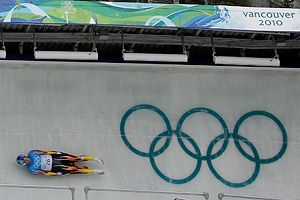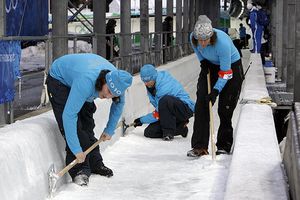WHISTLER, British Columbia — What is the proper response when an athlete dies in competition? Do you call a halt to what is, after all, merely a game, or do you go on with the show, tragedy be damned? Fortunately, this is a question we rarely must answer in sports. After the death of Georgian luger Nodar Kumaritashvili, the secretary general of the International Luge Federation (FIL) asked reporters to bear in mind that there hasn’t been a death in the sport since 1975.
“We haven’t experienced this in 35 years. We are unfamiliar with how to deal with this,” Svein Romstad said at a press conference Saturday morning. “You have a technical component and an emotional component, and in our discussion it became clear none of our athletes have experienced this. They lost …”
An IOC executive board member said it was too early to draw any long-term lessons from the crash.
At that point, Romstad broke down, unable to speak for several seconds before continuing in a shaking voice: “They lost a friend yesterday. And it is emotional for everyone.”
I never met Kumaritashvili; never even heard of him until Friday afternoon when his body went flying off his sled, over the wall and slammed into a support post. The accident was horrifying. You knew instantly that he was dead, that there was no way he could survive a crash like that. FIL president Josef Fendt called it the worst day in the sport’s history.
Yet if Kumaritashvili was like most athletes, I seriously doubt he would have wanted his death to halt the dreams of his fellow lugers who worked so long and trained so hard for their moment in the Olympics.
So there is no question the luge must go on, and it will. Even as Romstad was speaking, lugers were resuming their training runs. The only issue is making certain the track is safe enough.
After an investigation by the British Columbia coroners service, the police and luge officials, the FIL decided to raise the wall where the crash occurred, alter the ice profile and — most importantly — start the men’s competition from the lower women’s start position. The lower start will reduce speeds by up to 10 kph. Romstad said the changes were a combination of emotional and safety concerns.
“Largely this is so the athletes who have to get on that ice do so in a positive way,” said Vancouver Olympics Committee vice-president Tim Gayda. “We still want an Olympic competition but we still have to be respective of those athletes that their friend died on that track. That’s why we want to make sure that they’re able to step on there with confidence and get beyond there and have an Olympic competition.”
Luge is an inherently risky sport, and all athletes go into it with that knowledge. Luge bills itself as the fastest sport on ice, and sliders have reached 95 mph on the Whistler track. There are no brakes on a luge sled. The only way to steer is by leaning with your shoulders or applying pressure with your legs, and the only way to stop is to wait until you cross the finish line and then rely on gravity when the track heads back uphill. In other words, once you start down the track, there is no stopping until you reach the end. Unless, of course, you crash.

AP Photo/Sergey Ponomarev
Competitors tested out the changes to the track Saturday.
When I took part in luge camp four years ago, I had to sign a waiver that said I released USA Luge from any liability and accepted all risk of injury, including “permanent disability, paralysis and death.”
But death isn’t really supposed to be an inherent risk in luge. It has been an Olympic sport since 1964, and that first year was the only previous time a slider was killed in the Olympics. The last time a slider died at an artificial track in competition was 1975. The question is whether the Whistler track was at fault here or if it was simply a freak and very tragic accident.
The Whistler track’s incredible speed and its safety have been an issue since it opened two years ago, and Kumaritashvili’s death brings it into further question. Kumaritashvili was not the only athlete to crash during Friday’s training runs. Armin Zoeggeler, the 2002 and 2006 gold medalist from Italy, had a rare crash on the 11th curve. Romania’s Violeta Stramaturaru crashed and was knocked unconscious. The final curve where Kumaritashvili crashed is a complete U-turn that is so notorious lugers call it the “50-50 turn,” because you have a 50-50 chance of crashing there.
According to figures released by the FIL, there have been more than 5,000 luge runs on the track — Kumaritashvili had 26 runs here, 16 from the men’s start — and officials said the crash rate is not unusual, about 3 percent. Including all starting spots — men’s, women’s, junior and novice — in all events, there have been more than 30,000 runs on the track and 340 sled turnovers that required emergency medical response. The crash rate, however, has nearly quadrupled in the past year.
Georgian president Mikheil Saakashvili said that while he did not think the track builders were negligent, an athlete’s mistake should not lead to death. “We were told by other sportsmen and there were some suggestions this wall should have been higher there,” he said. “The good news is this wall will be higher. But the best news in the future would be that they listen more to the criticism of sportsmen.”

AP Photo/Michael Sohn
Workers modified the surface of the ice near the final turn of the track, and other alterations pushed back the reopening of the facility.
Fendt said luge tracks are fast enough and that he doesn’t want them getting any faster (he said there was talk that the track in Sochi, Russia, for the 2014 Olympics was going to be even faster than this one). The problem is they already are faster than an approximate 137 kph speed limit he proposed — Kumaritashvili was going 140 kilometers (about 90 miles) and Italy’s David Mair hit 152.5 kilometers (95 miles) on Friday. “There is nothing we can change about that,” Fendt said. “I’m not saying it is unsafe. I’m saying we do not want tracks in the future to get even faster.”
The high speeds are both the sport’s danger and its appeal. But while it’s exciting to say lugers can go nearly 100 mph at Whistler, there is no compelling reason for the track — or any future tracks — to be so fast. Racing at slower speeds does not hurt the fairness or the integrity of the sport, but it does lessen the chances of a fatality.
The FIL made the right decision to go on with the competition and to lower the start. There are two proper ways to show Kumaritashvili the proper respect. One is for the lugers to do today what he would have wanted: Compete for Olympic glory. The other is to make sure they aren’t risking their lives in doing so.
Jim Caple
senior writer for ESPN.com











































